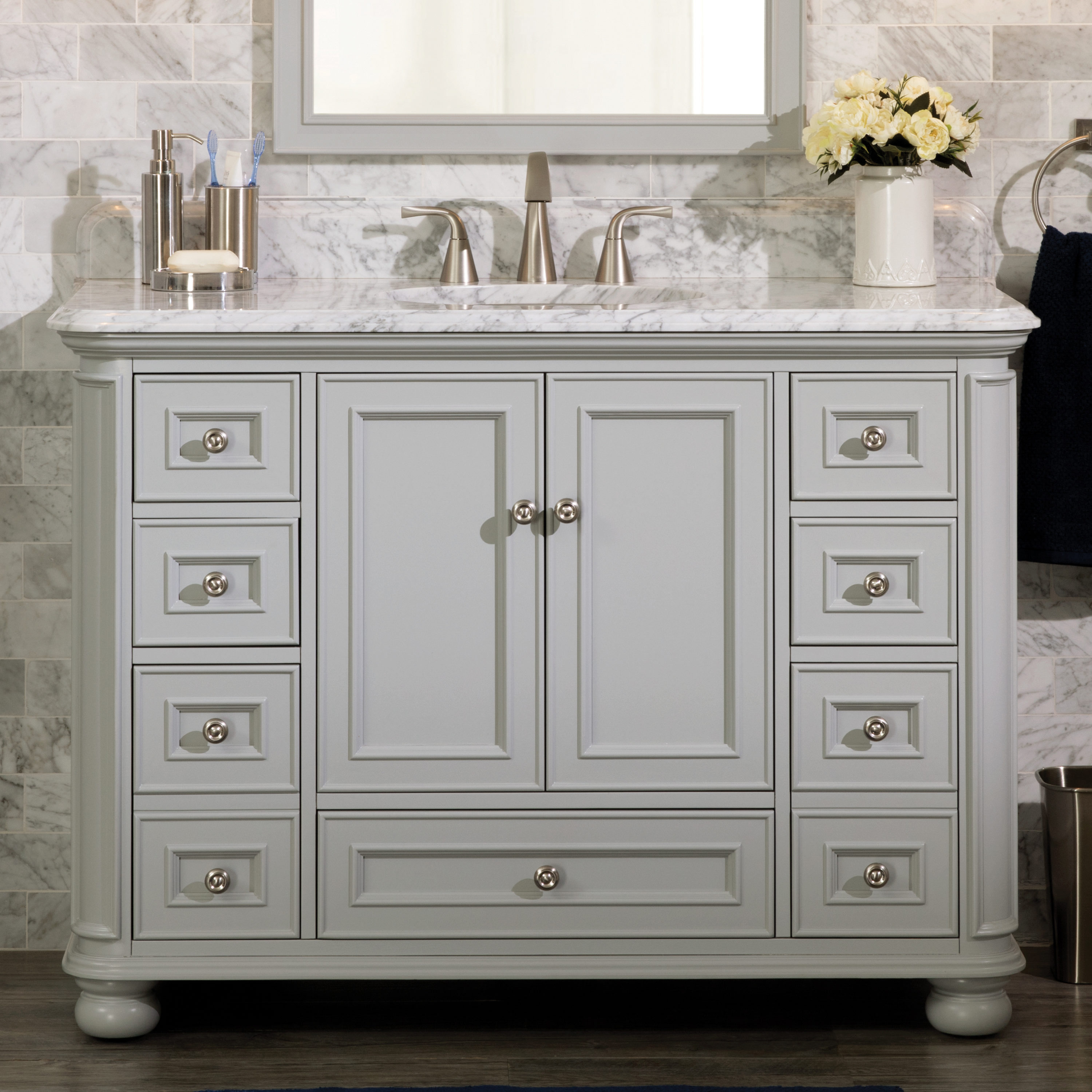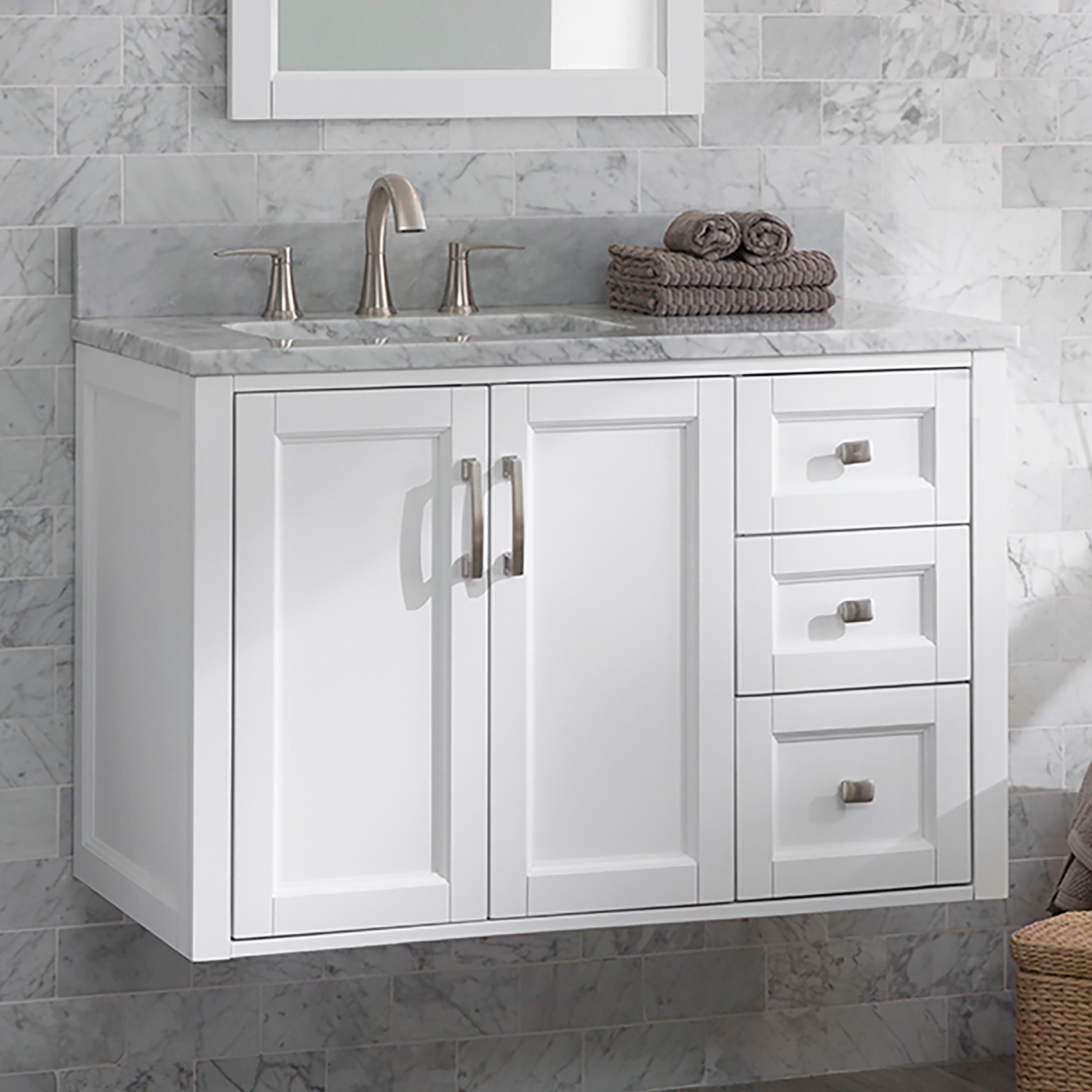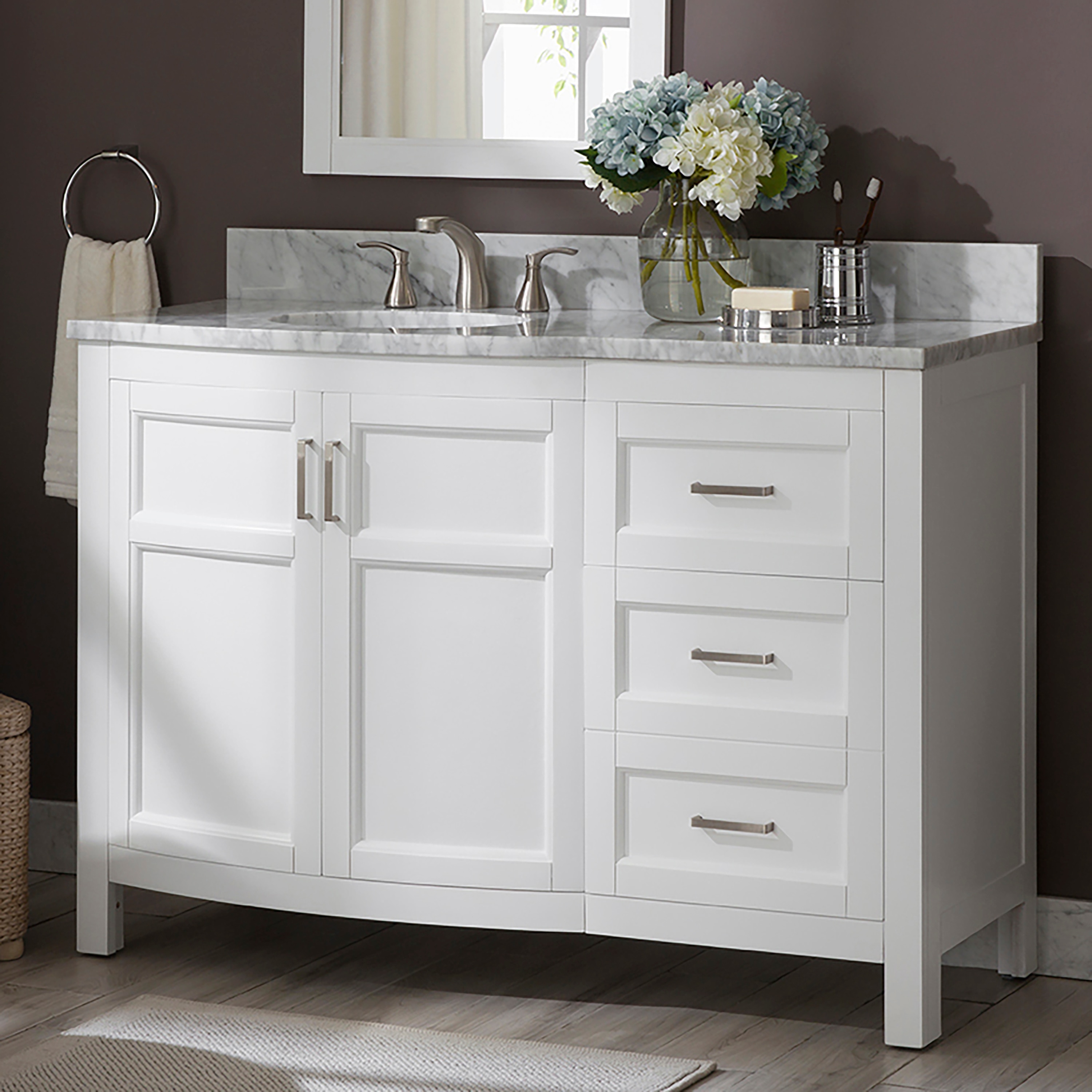Lowe’s 48″ Bathroom Vanity

A 48″ bathroom vanity is a popular choice for homeowners looking to upgrade their bathroom space. Lowe’s offers a wide selection of 48″ bathroom vanities in various styles, materials, and finishes to suit different tastes and budgets.
Styles of 48″ Bathroom Vanities, Lowes 48 bathroom vanity with top
Lowe’s offers a variety of 48″ bathroom vanity styles, catering to different aesthetic preferences.
- Traditional: These vanities feature intricate details, such as carvings, molding, and ornate hardware, creating a classic and elegant look.
- Modern: Modern vanities emphasize clean lines, minimalist design, and sleek finishes. They often incorporate materials like metal and glass for a contemporary feel.
- Transitional: Transitional vanities bridge the gap between traditional and modern styles. They offer a balance of classic elements with contemporary touches, creating a timeless and versatile look.
- Rustic: Rustic vanities feature natural materials like wood and stone, often with distressed finishes. They evoke a sense of warmth and comfort, ideal for creating a cozy and inviting atmosphere.
- Contemporary: Contemporary vanities are characterized by bold and geometric designs, often featuring unconventional materials and textures. They create a dramatic and statement-making focal point in the bathroom.
Features and Benefits of a 48″ Bathroom Vanity
A 48″ bathroom vanity offers several benefits, making it a practical and stylish choice for most bathrooms.
- Ample Storage: A 48″ vanity provides significant storage space for toiletries, towels, and other bathroom essentials, keeping the space organized and clutter-free.
- Spacious Countertop: The wider countertop offers ample room for sinks, faucets, and decorative items, creating a functional and aesthetically pleasing design.
- Versatile Design: 48″ vanities are versatile enough to fit into various bathroom layouts, making them suitable for both small and large bathrooms.
- Improved Functionality: The additional space offered by a 48″ vanity enhances the overall functionality of the bathroom, making it easier to use and maintain.
Pros and Cons of Choosing a 48″ Bathroom Vanity
Choosing a 48″ bathroom vanity involves considering both its advantages and potential drawbacks.
- Pros:
- Increased Storage: The larger size provides ample storage for all your bathroom essentials.
- Spacious Countertop: A wider countertop offers more room for sinks, faucets, and decorative items.
- Enhanced Functionality: The extra space improves the overall functionality of the bathroom.
- Aesthetic Appeal: A 48″ vanity can be a statement piece, enhancing the overall aesthetic of the bathroom.
- Cons:
- Space Requirements: A 48″ vanity requires a larger bathroom space, potentially limiting its suitability for smaller bathrooms.
- Higher Cost: Larger vanities generally cost more than smaller vanities.
- Installation Complexity: Installing a 48″ vanity might require professional assistance, especially in tight spaces.
Examples of 48″ Bathroom Vanities at Lowe’s
Lowe’s offers a wide range of 48″ bathroom vanities from various brands and models, each with unique features and styles.
- Signature Hardware: Signature Hardware offers a wide selection of 48″ bathroom vanities in various styles, including traditional, modern, and transitional. Their vanities are known for their high quality and craftsmanship.
- American Standard: American Standard offers a range of 48″ bathroom vanities that prioritize functionality and durability. Their vanities are known for their sleek designs and reliable performance.
- Kohler: Kohler is a renowned brand for its high-quality bathroom fixtures, including 48″ bathroom vanities. Their vanities are known for their innovative designs, superior craftsmanship, and durable construction.
- Glacier Bay: Glacier Bay offers a wide range of 48″ bathroom vanities at affordable prices. Their vanities are known for their modern designs and practical features.
- Home Decorators Collection: Home Decorators Collection offers a range of 48″ bathroom vanities with stylish designs and practical features at competitive prices. Their vanities are known for their versatility and affordability.
Choosing the Right 48″ Bathroom Vanity for Your Needs: Lowes 48 Bathroom Vanity With Top

A 48″ bathroom vanity offers ample storage and counter space, making it an ideal choice for many bathrooms. Selecting the right vanity for your needs requires careful consideration of your bathroom style, budget, space constraints, and desired features.
Determining the Best Fit for a 48″ Vanity
Accurately measuring your bathroom space is crucial to ensure the 48″ vanity fits seamlessly. Here’s a step-by-step guide:
- Measure the available wall space: Determine the exact width of the wall where you intend to place the vanity. This will help you confirm if a 48″ vanity fits comfortably.
- Consider the door swing: If the vanity is positioned near a door, ensure there’s sufficient clearance for the door to open fully without hitting the vanity.
- Account for plumbing: Measure the distance between the existing plumbing fixtures and the wall. This will ensure the vanity can be connected to the water supply and drain lines without any issues.
Considering Sink Type and Material
The sink is an integral part of the vanity, and its type and material play a significant role in the overall look and functionality of your bathroom.
- Undermount sinks: These sinks are installed beneath the countertop, creating a seamless and modern look. They are typically made of porcelain, ceramic, or stainless steel.
- Top-mount sinks: These sinks are placed on top of the countertop, offering a classic and traditional style. They are often made of porcelain, ceramic, or cast iron.
- Vessel sinks: These stylish sinks are placed on top of the countertop and are typically smaller than undermount or top-mount sinks. They are often made of porcelain, ceramic, glass, or stone.
Installing a 48″ Bathroom Vanity

Installing a 48″ bathroom vanity can be a rewarding DIY project, allowing you to personalize your bathroom and potentially save on labor costs. This guide provides a comprehensive step-by-step process, addressing essential tools, materials, and tips for a successful installation.
Tools and Materials
A successful vanity installation requires a set of tools and materials. Having these readily available before you begin ensures a smooth process.
- Tools: Level, stud finder, tape measure, pencil, screwdriver, drill, saw, wrench, pipe wrench, pliers, utility knife, safety glasses, gloves.
- Materials: Vanity cabinet, vanity top, sink, faucet, drain assembly, plumbing supplies (P-trap, supply lines, shut-off valves), electrical supplies (outlet box, electrical wire, outlet), mounting hardware (screws, anchors, brackets), silicone sealant, caulk, wood shims.
Preparing for Installation
Before starting the installation, it’s crucial to prepare the space and ensure the vanity fits correctly.
- Clear the area: Remove any existing fixtures, furniture, or obstructions from the bathroom space where the vanity will be installed. This allows for easier access and movement during the installation process.
- Check the dimensions: Measure the space where the vanity will be installed and ensure it fits properly. This includes verifying the width, depth, and height of the vanity. Allow for adequate clearance around the vanity for doors to open and close freely.
- Locate studs: Use a stud finder to locate the wall studs behind the area where the vanity will be mounted. These studs provide structural support for the vanity and ensure stability. Mark the stud locations on the wall with a pencil.
- Prepare the floor: Ensure the floor is level and stable. If necessary, use shims to level the floor and create a solid foundation for the vanity.
Installing the Vanity Cabinet
The vanity cabinet is the base of the installation. It’s essential to secure it properly to the wall for stability and durability.
- Position the vanity: Carefully position the vanity cabinet in the desired location, ensuring it is centered and aligned with the wall. Use a level to check for any unevenness.
- Attach the vanity: Secure the vanity cabinet to the wall studs using the provided mounting hardware. If necessary, use anchors for drywall walls. Make sure the screws are long enough to reach into the studs for secure attachment.
- Level the vanity: Once the vanity is attached to the wall, use a level to ensure it is level. If necessary, adjust the vanity by adding or removing shims under the cabinet legs.
Installing the Vanity Top
The vanity top is where the sink and faucet are installed. Proper installation ensures functionality and aesthetic appeal.
- Position the vanity top: Carefully position the vanity top on top of the vanity cabinet. Make sure the sink cutout aligns with the vanity cabinet opening. Use a level to ensure the vanity top is level.
- Secure the vanity top: Depending on the type of vanity top, it may be secured with clips, screws, or adhesive. Follow the manufacturer’s instructions for the specific installation method.
- Apply sealant: Apply a bead of silicone sealant around the perimeter of the vanity top where it meets the vanity cabinet. This helps prevent water damage and creates a clean, finished look.
Installing the Sink
The sink is an integral part of the vanity. It’s crucial to ensure it’s properly installed for functionality and aesthetic appeal.
- Position the sink: Carefully position the sink within the vanity top cutout. Make sure the sink is centered and aligned with the vanity top.
- Secure the sink: Depending on the type of sink, it may be secured with clips, screws, or adhesive. Follow the manufacturer’s instructions for the specific installation method.
- Apply sealant: Apply a bead of silicone sealant around the perimeter of the sink where it meets the vanity top. This helps prevent water damage and creates a clean, finished look.
Installing the Faucet
The faucet is the final piece of the vanity installation. Proper installation ensures functionality and water flow.
- Prepare the faucet: Install the faucet cartridges and handles according to the manufacturer’s instructions. Ensure the faucet is assembled correctly and ready for installation.
- Position the faucet: Carefully position the faucet on the sink, ensuring it is centered and aligned. Make sure the faucet holes on the sink align with the faucet base.
- Secure the faucet: Secure the faucet base to the sink using the provided mounting hardware. Tighten the screws or nuts securely, ensuring the faucet is firmly attached.
- Connect the supply lines: Connect the faucet supply lines to the shut-off valves, ensuring they are securely tightened. Use pipe tape on the threads to prevent leaks.
Connecting Plumbing
Connecting the plumbing is crucial for the functionality of the vanity. Ensure proper installation to prevent leaks and ensure proper drainage.
- Install the P-trap: Connect the P-trap to the drain outlet of the sink. Make sure the P-trap is securely tightened and the drain pipe is properly connected to the waste line.
- Connect the supply lines: Connect the supply lines to the shut-off valves, ensuring they are securely tightened. Use pipe tape on the threads to prevent leaks.
- Test for leaks: Turn on the water supply and check for leaks at the faucet, supply lines, and P-trap. Tighten any loose connections and address any leaks immediately.
Connecting Electrical
If the vanity has an electrical outlet, proper installation is essential for safety and functionality.
- Install the outlet box: Mount the outlet box to the wall stud behind the vanity, ensuring it is level and securely attached. Use the appropriate mounting hardware for the wall type.
- Connect the wiring: Connect the electrical wires to the outlet, ensuring the connections are secure and correctly wired according to the electrical code. Use wire nuts to secure the connections.
- Install the outlet: Install the outlet in the outlet box, ensuring it is securely attached and the screws are tightened. Make sure the outlet is properly grounded.
- Test the outlet: Plug a test device into the outlet to ensure it is working properly. Verify the outlet is functioning correctly before using it.
Tips for a Successful Installation
- Read the instructions: Before starting the installation, carefully read the manufacturer’s instructions for the vanity, sink, faucet, and other components. This ensures you understand the specific installation process and requirements.
- Measure twice, cut once: Double-check all measurements before cutting any materials or drilling any holes. This helps prevent mistakes and ensures everything fits correctly.
- Use a level: Regularly use a level to ensure all components are installed level and plumb. This ensures the vanity is aesthetically pleasing and functions correctly.
- Apply sealant: Use silicone sealant around the perimeter of the vanity top, sink, and faucet to prevent water damage and create a clean, finished look.
- Clean up: Clean up any debris or spills during the installation process. This prevents accidents and ensures a clean and organized work area.
